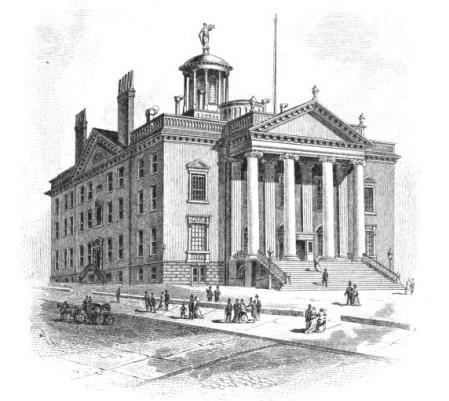Members 32 Members 126 | Party control Bucktail (19-13) | |
 | ||
Term July 1, 1820 – June 30, 1821 President Lt. Gov. John Tayler (Clint.) | ||
The 44th New York State Legislature, consisting of the New York State Senate and the New York State Assembly, met from November 7, 1820, to April 3, 1821, during the fourth year of DeWitt Clinton's governorship, in Albany.
Contents
Background
Under the provisions of the New York Constitution of 1777, amended by the Constitutional Convention of 1801, 32 Senators were elected on general tickets in the four senatorial districts for four-year terms. They were divided into four classes, and every year eight Senate seats came up for election. Assemblymen were elected countywide on general tickets to a one-year term, the whole Assembly being renewed annually.
In 1797, Albany was declared the State capital, and all subsequent Legislatures have been meeting there ever since. In 1818, the Legislature enacted that future Legislatures meet on the first Tuesday of January of each year unless called earlier by the governor.
On January 18, 1820, a caucus of 64 Bucktail legislators nominated U.S. Vice President Daniel D. Tompkins for Governor and State Senator Benjamin Mooers for Lieutenant Governor. A meeting of citizens at Albany nominated Gov. DeWitt Clinton and Lt. Gov. John Tayler for re-election. The Federalists did not nominate candidates for Governor or Lieutenant Governor, and the party began to disband: the vast majority of them supported Clinton, a minority—calling themselves the "High-minded Federalists" (among them William A. Duer and John A. King)—supported Tompkins and joined the Bucktails.
At this time the politicians were divided into two opposing political parties: the Federalists and the Democratic-Republicans. The Democratic-Republican Party was split into two factions: the Clintonians (supporters of Gov. DeWitt Clinton) and the Bucktails (led by Martin Van Buren, and including the Tammany Hall organization in New York City).
Elections
The State election was held from April 25 to 27, 1820. Gov. DeWitt Clinton and Lt. Gov. John Tayler were re-elected.
Senators Walter Bowne (Southern D.) and Ephraim Hart (Western D.) were re-elected. John Lefferts (Southern D.), William C. Bouck, John J. Miller, Tilly Lynde (all three Middle D.), Elijah Miles ( Western D.), and Assemblyman Oliver Forward (Western D.) were also elected to the Senate. Hart, Miles and Forward were Clintonians, the other five Bucktails.
Sessions
The Legislature met at the Old State Capitol in Albany on November 7, 1820, to elect presidential electors; and adjourned on November 20.
Peter Sharpe (Buckt.) was elected Speaker with 69 votes against 52 for John C. Spencer (Clint.), the Speaker of the previous session. Dirck L. Vanderheyden was elected Clerk of the Assembly with 63 votes against 62 for the incumbent Aaron Clark.
On November 8, a Bucktail Council of Appointment was chosen, with a vote of 71 to 54. However this Council did not meet before January 1821, when the previous Council's term expired. Then they removed almost all Clintonian office-holders and appointed Bucktails instead.
On November 9, the Legislature chose 29 electors, all Bucktails: William Floyd, Henry Rutgers, Abel Huntington, Edward Leverich, Isaac Lawrence, John Targee, Jacob Odell, Peter Waring, Edward P. Livingston, David Hammond, Peter Millikin, Mark Spencer, Benjamin Knower, Gilbert Eddy, Howell Gardner, John Baker, John Walworth, Daniel McDougal, Seth Wetmore, Latham A. Burrows, Farrand Stranahan, Henry Wager, Elisha Farnham, Jonathan Collins, Samuel Nelson, William B. Rochester, Charles Thompson, Philetus Swift, James Brisban. Floyd and Wetmore did not attend the meeting of the electoral college, and Martin Van Buren and William I. Dodge were appointed to fill the vacancies. They cast their votes for James Monroe and Daniel D. Tompkins.
On November 18, the Legislature passed a bill calling for a convention with unlimited powers to amend the State Constitution. Two days later, the Council of Revision rejected the bill: Chancellor James Kent and Chief Justice Ambrose Spencer voted against it; Judges Joseph C. Yates and John Woodworth for it; and Gov. DeWitt Clinton broke the tie voting against it.
The Legislature met for the regular session on January 9, 1821, and adjourned on April 3.
At the beginning of this session, the Legislature passed a bill to submit the question, whether a Constitutional Convention should be called, to the people at the next annual State election, to be held in April 1821. The people answered in the affirmative, delegates to the New York State Constitutional Convention of 1821 were elected in June, and the Convention met from August to November 1821. The new Constitution was adopted by popular vote in January 1822.
On January 29, the Legislature appointed Benjamin Knower (Buckt.) to succeed Gerrit L. Dox as New York State Treasurer.
On February 6, the Legislature elected Martin Van Buren (Buckt.) to succeed Nathan Sanford (Clint.) as U.S. Senator from New York for a term beginning on March 4, 1821.
On March 21, the Legislature added State Senator William C. Bouck (Buckt.) to the Erie Canal Commission.
Districts
Members
The asterisk (*) denotes members of the previous Legislature who continued in office as members of this Legislature. Oliver Forward changed from the Assembly to the Senate.
Employees
Assemblymen
The asterisk (*) denotes members of the previous Legislature who continued as members of this Legislature.
